Seen from Space 2006
SST rising in the northern high-latitude ocean in summer as observed by AMSR-E
| |
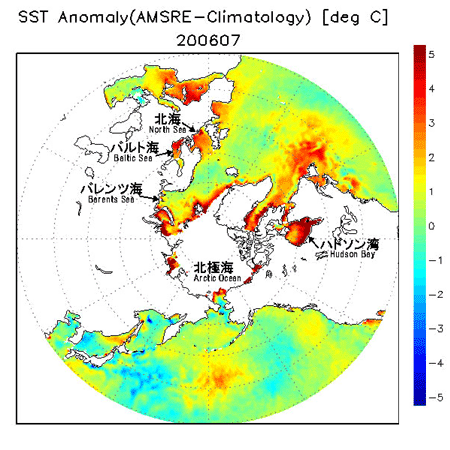 |
| Fig.1 Sea Surface Temperature Anomaly in July 2006 |
Data analysis of the sea surface temperature (SST) observed by AMSR-E clarified that the SST rises significantly in the ocean at the northern high latitudes from its 30-year averaged means, particularly in summer. Figure 1 captures SST anomalies observed by AMSR-E in July 2006, where anomalies are defined as departures from the climate SST. *1 Areas with positive anomalies of a few degree centigrade are found in the Barents Sea, around Greenland, and in Hudson Bay. Areas with anomalies exceeding 4-5oC are found in the neighborhood of sea ice boundaries. A steady tendency of positive anomalies has been found every summer since AMSR-E observations began in July 2002. White areas in the Arctic Ocean indicate sea ice coverage in summer.
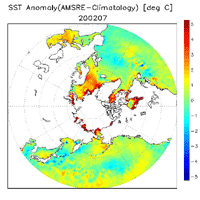 |
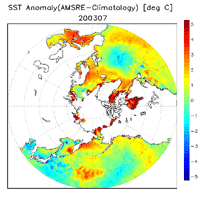 |
| (a) 2002 |
(b) 2003 |
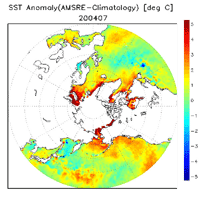 |
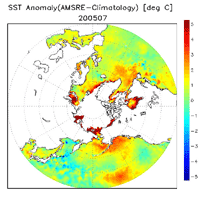 |
| (c) 2004 |
(d) 2005 |
| Fig.2 SST Anomaly in July 2002 to July 2005 |
Figures 2 (a) to (d) capture SST anomalies in July 2002 to July 2005. Areas with positive SST anomalies move around from year to year, but similar tendencies of positive anomalies are observed. Small areas with positive anomalies were found around Alaska in July 2006, and significant positive SST anomalies were found in July of 2003 to 2005 (three years).
As seen above, it seems that a tendency of positive SST anomalies may have become established in recent summers in the northern high-latitude ocean. These positive SST anomalies may be closely related to a decrease of the sea ice distribution in the Arctic Ocean2* and may possibility be related to global warming.
Furthermore, Europe is suffering from unusually high temperatures this summer, and a related phenomenon is also found in SST anomalies. In particular, significant positive SST anomalies are found in the Mediterranean Sea, the North Sea, and the Baltic Sea, as illustrated in Fig. 1. These summer SST anomalies are comparable to those observed in the summer of 2003. Therefore, the heat wave in Europe this summer may correspond to the one in the summer of 2003. *3 *4
The above SST anomalies observed by AMSR-E in the northern high-latitude ocean will be posted on the AMSR/AMSR-E site in the near future.
Explanation of the images:
(Fig. 1 and Fig. 2)
|
 |
|









